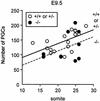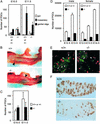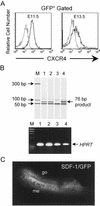Impaired colonization of the gonads by primordial germ cells in mice lacking a chemokine, stromal cell-derived factor-1 (SDF-1)
- PMID: 12684531
- PMCID: PMC154343
- DOI: 10.1073/pnas.0730719100
Impaired colonization of the gonads by primordial germ cells in mice lacking a chemokine, stromal cell-derived factor-1 (SDF-1)
Abstract
Primordial germ cells (PGCs) are the founders of sperm or oocytes. PGCs migrate through the tissues of the embryos and colonize the gonads during development. However, the cytokines essential for colonization of the gonads by PGCs in mammals remain unclear. Stromal cell-derived factor-1 (SDF-1, also called PBSF and CXCL12) is a member of chemokines, a family of structurally related chemoattractive cytokines. SDF-1 and its primary physiologic receptor CXCR4 have multiple essential functions in development including colonization of bone marrow by hematopoietic cells and neuron localization within cerebellum during embryogenesis as well as B lymphopoiesis and cardiovasculogenesis. Here, we have shown that PGCs have cell-surface expression of CXCR4 and that, in SDF-1(-/-) mice, PGCs undergo directed migration through tissues of embryos, but the numbers of PGCs in the gonads are significantly reduced. The proliferation of PGCs within the gonads seems normal in the mutant mice. These findings reveal the essential role for SDF-1 in murine PGC development likely by controlling colonization of the gonads by PGCs.
Figures



References
Publication types
MeSH terms
Substances
LinkOut - more resources
Full Text Sources
Other Literature Sources
Molecular Biology Databases

